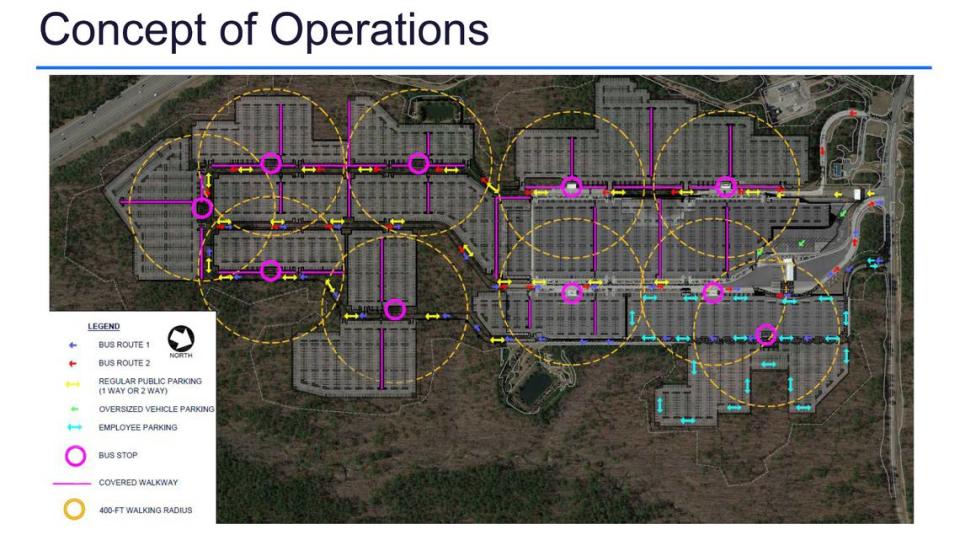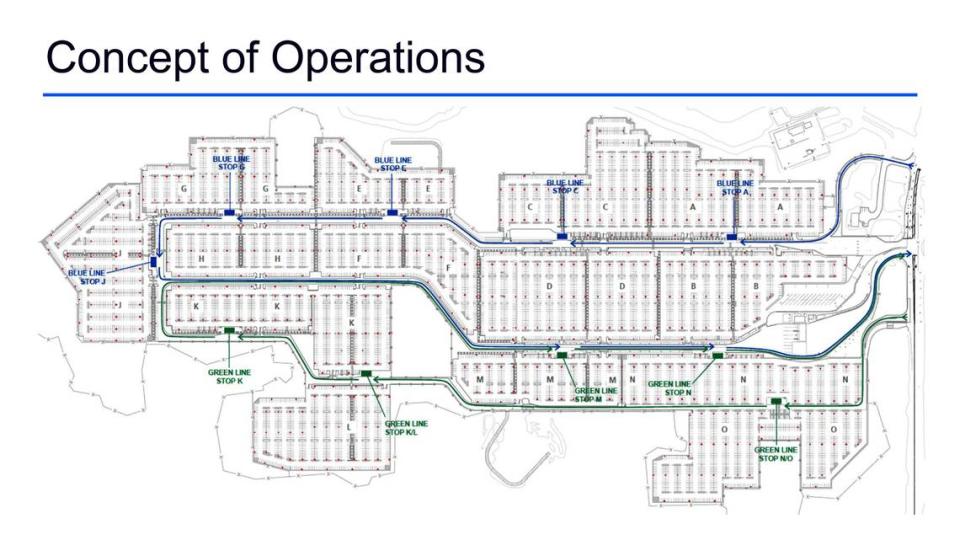RDU airport will build 7,000 parking spaces near Umstead. Will the park be harmed?
Raleigh-Durham International Airport will soon begin clearing trees and moving dirt to nearly triple the size of its remote parking lot near Interstate 40 and William B. Umstead State Park.
The airport’s governing board voted Thursday to approve the first of several contracts that will add 7,000 spaces to Park Economy 3 off National Guard Drive and Airport Boulevard. When the work is done in early 2025, the remote parking lot will have nearly 11,000 spaces within a shuttle bus ride of the airport’s two passenger terminals.
The decision was unanimous, despite misgivings by a few board members about the project’s environmental impacts. They worried about replacing trees with 65 acres of pavement. They were also disappointed that the airport’s plans did not include any electric vehicle chargers or solar panels over the spaces or on the roofs of walkways and shelters.
Nina Szlosberg-Landis, who represents Raleigh on the board, said she was concerned the airport wasn’t doing enough with the project to minimize fossil fuel emissions that contribute to climate change.
“While we have a sense of urgency of taking care of the parking conditions for our customers and moving forward with our plans, there is an equal urgency in terms of trying to do what we can to address the climate crisis,” Szlosberg-Landis said.
David Kushner, who represents Wake County, said he sought assurances that the airport would cut no more trees than it has to. In recent days, Kushner said, he and airport staff identified about an acre near a stormwater pond that could be kept wooded.
“It may not sound like a lot, but that’s going to be dozens and dozens of trees,” he said. “I’m glad we could save them. I’m sorry we can’t save more.”
Ellis Hankins, the board’s chairman, said there is still time to consider adding EV chargers and solar panels to the project and that the board will hold a special meeting in September to look at options. But Hankins, who also represents Wake on the board, said the airport needs more parking.
“Some people say, ‘Just don’t build it and then the cars won’t come,’” he said. “Oh, yes they will, and we’ll have a lot of frustrated people. So that’s just not a realistic alternative.”
The $130 million parking lot is the first of several big construction projects the airport will begin in coming years to try to modernize and keep up with demand. Others include a new main runway; more gates in Terminal 1; additional ticketing and baggage claim space in Terminal 2; a larger Customs and Border Patrol area for international flights; and new areas for ground transportation and rental cars near the terminals.
Why does RDU need 7,000 more parking spaces?
RDU officials say the additional spaces are needed in part to keep up with growing demand for parking. Including its two remote parking lots and the decks between the terminals, the airport has 17,901 parking spaces today, with another 1,000 coming online soon as it reopens its Express lot off International Drive. It expects to need more than 21,800 spaces in 2026 and between 24,825 and 28,734 by 2033, said Bill Sandifer, RDU’s chief development officer.
“So the inevitable conclusion for me is we need to build as fast as we can that expansion of Park Economy 3,” Sandifer told airport board members last week. “We’ve really got some short-term pressures in terms of being able to provide parking for our customers.”

The larger lot will also help make up for the planned loss of parking spaces elsewhere at the airport.
In 2025, RDU expects to demolish two small parking decks near Terminal 2 to begin expansion of the terminal building and realignment of John Brantley Boulevard. Along with nearby surface lots, the airport will lose about 3,055 spaces. If all goes well, a new parking structure with 3,130 spaces will take their place next to Terminal 2 by 2028.
And RDU plans to eventually close its smaller remote lot, Park Economy 4, off International Drive. That surface lot, with 3,300 spaces, is needed for expansion of the air cargo operations at the north end of the airfield, Sandifer said.
“Air cargo has no where to grow today. They’re out of space,” he said. “So in the next five- to 10-year period of time, I fully expect those folks are going to be knocking on our door, like the airlines are, saying you’re going to have to provide us more space. That’s the location to do it.”
Will the larger lot affect the state park next door?
Board members said they heard from hundreds of residents and local politicians about the expansion. Many were concerned about clearing and paving forested land adjacent to William B. Umstead State Park.
Park Economy 3 now covers about 36 acres surrounded by forest. RDU plans to expand in three directions, adding about 65 acres of pavement and clearing a total of 120 acres, coming as close as 320 feet of the park.
RDU says it should be able to build and maintain the expanded lot without affecting the park or harming streams and wetlands on the property or downstream. The new sections are irregularly-shaped to minimize earth moving, avoid streams and allow room for seven new ponds for controlling storm runoff.
The ponds are called submerged gravel wetlands, a relatively new design in North Carolina that filters water in rock basins that are covered with a layer of earth and plants. Airport officials say they wanted to avoid open water that might attract birds that could interfere with airplanes.
But not everyone is convinced the new design is an improvement.
The Umstead Coalition, an advocacy group for the park, questions several of the assumptions and claims in the airport’s report on the environmental effects of the project, including the effectiveness of the submerged wetlands. The coalition says the designs are harder to maintain, don’t appear to cleanse water any better than other types of ponds and wetlands and won’t reduce the volume of stormwater leaving the site.
“While we applaud (the airport) for looking at innovative stormwater control measures, we strongly suspect the proposed Subsurface Gravel Wetlands (SGW) are not appropriate for this application,” the coalition wrote in a critique of the airport’s plans.
Jean Spooner, who leads the coalition, said she’d like to see the airport commit to monitoring water quality in Haley’s Branch, the creek downstream of the parking lot, to see how the stormwater system is working and that dirt doesn’t leave the site during construction.
“If they’re going to do good, let’s see it,” Spooner said in an interview. “And that will help ensure they do good.”
How the new parking lot will work
RDU officials say they’re building more surface parking rather than another deck to save money and keep parking rates more reasonable. At $130 million, the new lot is expected to cost about $18,571 per space, Sandifer said, compared to an estimated $59,100 per space in a garage.
Because of the lot’s size, RDU plans to operate two separate bus routes to and from the terminals. Travelers will be encouraged to remember where they parked and which bus they’ll need to catch to retrieve their car. Each route will have five stops, putting more than 80% of spaces within 400 feet of a bus stop, said John Holmes, a design engineer for the consulting firm RS&H.

Walkways leading to the stops will be covered, and the stop shelters will include monitors that show bus locations and possibly the latest flight information, Holmes said. The airport also plans a new building in the lot with public restrooms and offices for security and maintenance workers and equipment.
For the first time, the lot will also have parking for oversize vehicles, such as RVs or trucks with trailers.
Critics of the lot have asked why the airport continues to encourage people to drive rather than take public transit to and from the airport.
Sandifer notes that RDU draws travelers from throughout central and eastern North Carolina and that 55% of RDU passengers live outside areas that are served by public buses. In addition, a third of flights leave by 8 a.m., requiring travelers to be at the airport in the pre-dawn hours before buses are available.
But even during the day, transit options are limited. RDU is served by only one public bus system, GoTriangle, which on weekdays between 6:30 a.m. and 6 p.m. operates a shuttle between the airport and its regional transit center near RTP, where riders must transfer to another bus. At night and on weekends GoTriangle Route 100, an express bus between the regional transit center and downtown Raleigh, stops at the airport, though only every hour on weekends.
For most Triangle residents, public transit is impractical, Sandifer said.
“You can fly from here to Iceland faster than you can get to RDU from one of these outlying areas that is served by public transportation,” he said. “That’s not a criticism of the system; it’s a reflection and an understanding that it needs to get better at some point in the future to be able to serve the needs of customers of the airport.”


